Saturday, 22 November 2025
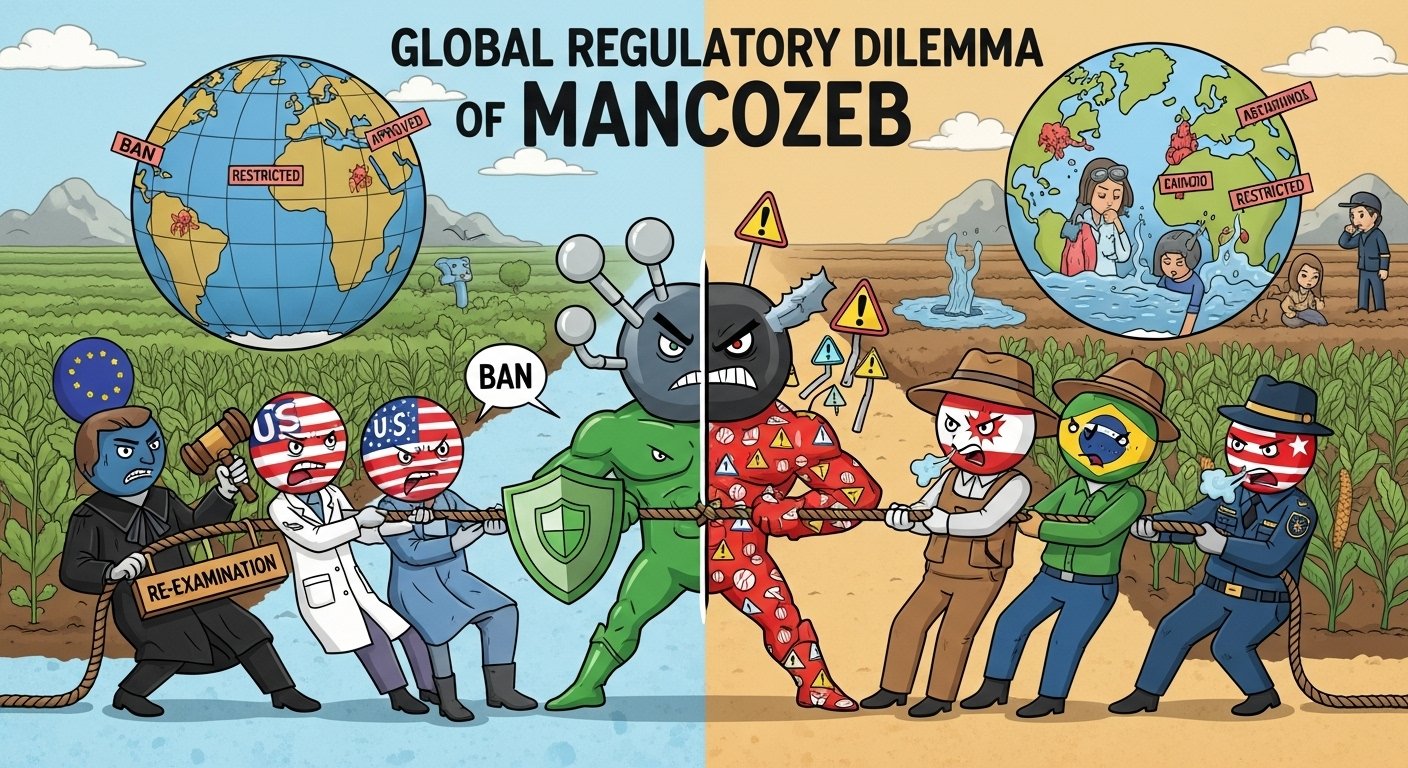
Mancozeb, that ubiquitous arbiter of phytopathological destiny, continues to bestride the globe as an indispensable fungicidal panacea, even as the European Union has cast it into regulatory obsolescence on grounds of speculative toxicology. Its multisite mode of action, coupled with an enviable paucity of resistance development, renders it indispensable for high-value horticultural and agronomic commodities—from India’s grapes and potatoes to Latin America’s bananas and Brazil’s soybeans. Yet the global regulatory tableau is a patchwork of prudence and profligacy: while North America permits its judicious deployment, India confronts an incomplete evidentiary edifice and the concomitant peril to trade and farmer livelihoods. Empirical case studies elucidate the stark economic and agronomic ramifications of an abrupt excision—diminished yields, escalated input costs, and disrupted export flows—which may well outweigh the conjectural health risks if employed under Good Agricultural Practices. Mancozeb thus embodies the quintessential conundrum of contemporary agriculture: the delicate dialectic between human health, agronomic imperatives, and global food security in an era of climate volatility and international interdependence.
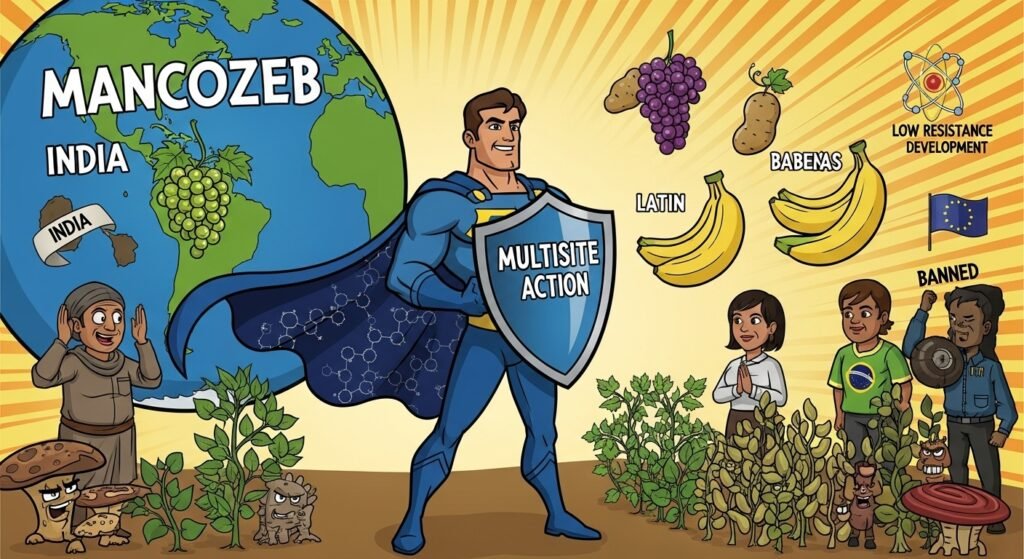
Mancozeb, an ethylene-bis-dithiocarbamate (EBDC), stands as one of the globe’s most extensively employed fungicides, esteemed for its broad-spectrum efficacy and remarkable cost-efficiency. Its multisite mode of action allows it to inhibit diverse fungal metabolic pathways, rendering the emergence of resistance exceedingly improbable. In an era in which crop diseases are evolving at a pace that outstrips chemical interventions, Mancozeb has remained an unwavering ally of farmers across continents. Yet, paradoxically, while it is proscribed in the European Union, it remains indispensable in India, Latin America, and other burgeoning agricultural economies. This regulatory disjunction epitomises a global dilemma: the delicate reconciliation of human health imperatives with the exigencies of agricultural productivity and food security.
Mancozeb: A Fungicide with Global Reach
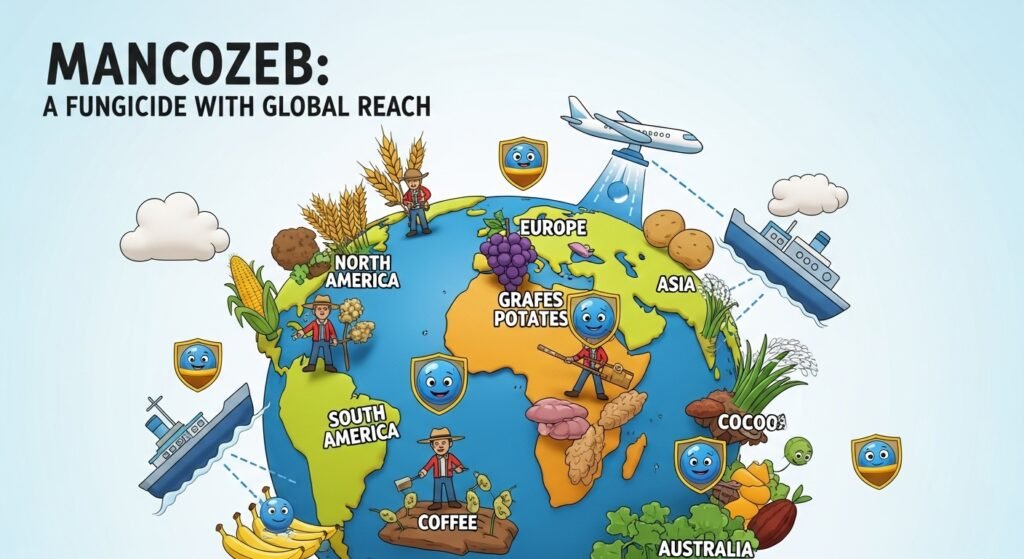
Across the globe, Mancozeb finds application on a vast array of crops, from the potato fields and vineyards of India and the United Kingdom, to the banana plantations of Latin America, and the sprawling soybean belts of Brazil. Its paramount advantage lies in its multisite mode of action, whereby it simultaneously impedes multiple fungal metabolic pathways. Unlike systemic fungicides, which assail a solitary enzyme or receptor and thus succumb readily to pathogen adaptation, Mancozeb would necessitate the improbable mutation of myriad genes for resistance to arise. It is this very characteristic that has enshrined it as a cornerstone of integrated disease management, frequently deployed in concert with systemic fungicides to combat recalcitrant pathogens such as Plasmopara viticola, the agent responsible for downy mildew in grapes.
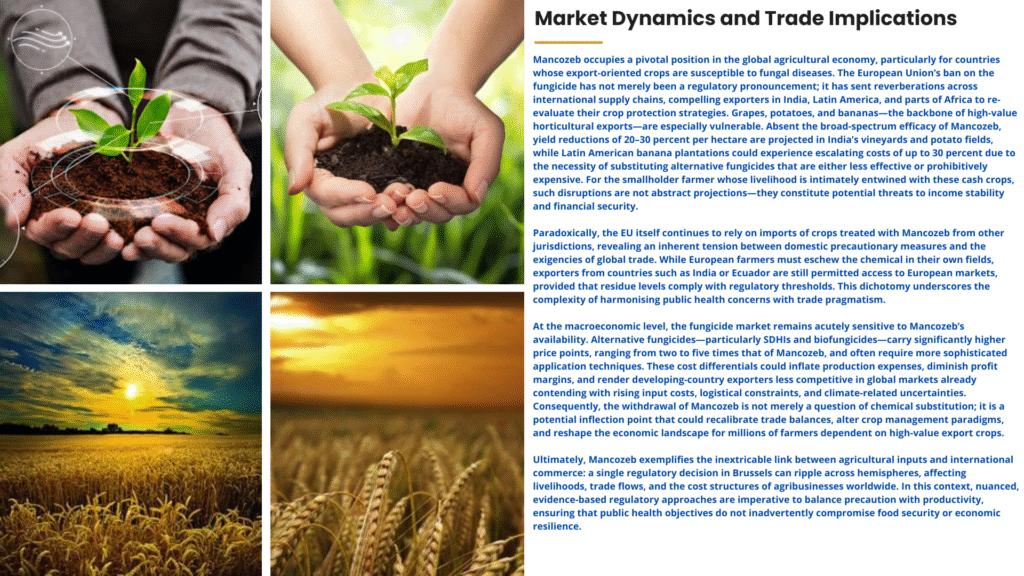
According to statistics furnished by the Indian government, India alone produces an estimated 500,000 million tonnes of Mancozeb annually, available in a spectrum of formulations including 35% SC, 75% WG, and 75% WP. Beyond Indian shores, Mancozeb retains pre-eminence in the control of potato diseases in the U.K., bananas across Central and South America, and soybeans in Brazil. Its exceptional versatility, coupled with an affordability—generally ranging between $5 and $10 per kilogram—renders it indispensable not only to smallholder farmers but also to large-scale agribusiness enterprises, bridging the imperatives of economic prudence and agricultural efficacy.
To understand Mancozeb’s global position, it is important to compare it with alternative fungicides:
| Fungicide Type | Mode of Action | Resistance Risk | Environmental Impact | Cost (USD/kg) |
| Mancozeb | Multisite inhibitor | Low | Low | 5–10 |
| Biofungicides | Biological control | Very Low | Very Low | 15–25 |
| Copper Fungicides | Contact protectant | Moderate | Moderate | 10–20 |
| SDHI Fungicides | Specific enzyme inhibitor | High | Low | 20–30 |
Source: ACS Agricultural Science & Technology, 2022; FAO Pesticide Data
Regulatory Landscape: A Global Patchwork
Mancozeb’s regulatory status varies sharply across regions, reflecting differences in risk assessment, agricultural priorities, and market sensitivity.
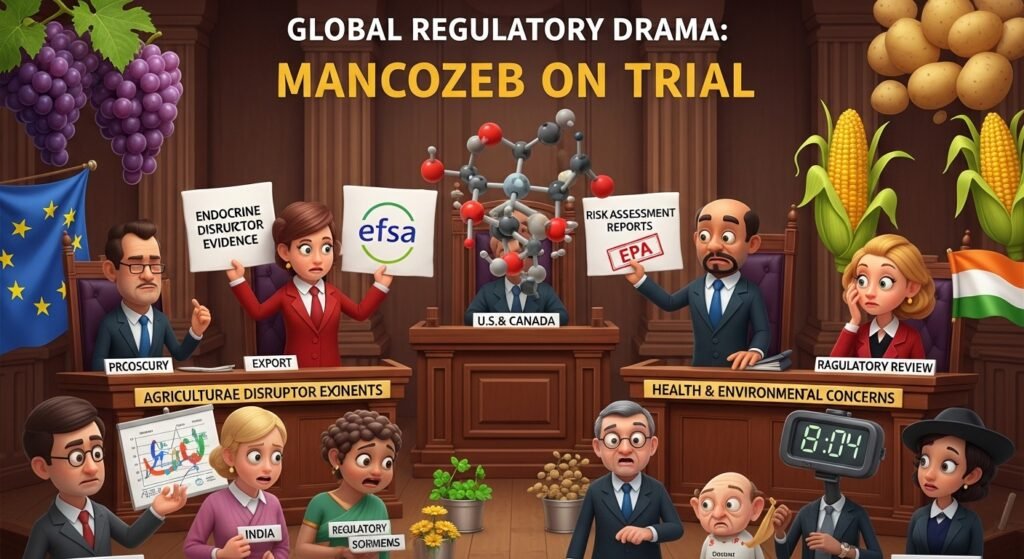
European Union
On the 14th of December, 2020, the European Commission promulgated Regulation (EU) 2020/2087, thereby proscribing the use of mancozeb, predicated upon its classification as a potential endocrine disruptor. The European Food Safety Authority (EFSA), whilst acknowledging the lacunae inherent in compound-specific analytical methodologies, nonetheless proceeded with the prohibition, invoking the precautionary principle as the lodestar of its regulatory reasoning.
Although the European Union has rescinded approval, mancozeb continues to enjoy provisional sanction within the United Kingdom until the 31st of January, 2024. This interdiction has reverberated across the corridors of global commerce, for EU residue thresholds now exert a determinative influence upon exporters in India, Latin America, and sundry other trading partners, thereby entwining scientific prudence with the imperatives of international agrarian trade.
United States
In contradistinction, the United States Environmental Protection Agency (EPA) has undertaken successive and scrupulous evaluations of mancozeb, ultimately adjudging that the acute, chronic, and carcinogenic dietary risks remain comfortably beneath the threshold of concern, provided the compound is employed in strict accordance with label directives. The EPA’s re-registration exercise of 2005 reaffirmed mancozeb’s safety profile, highlighting its negligible acute toxicity and the acceptably circumscribed risk associated with ETU metabolites, which frequently feature in toxicological disputations. A consonant appraisal has been rendered by Canadian authorities, who have sanctioned its continued utilisation within a framework of regulated oversight.
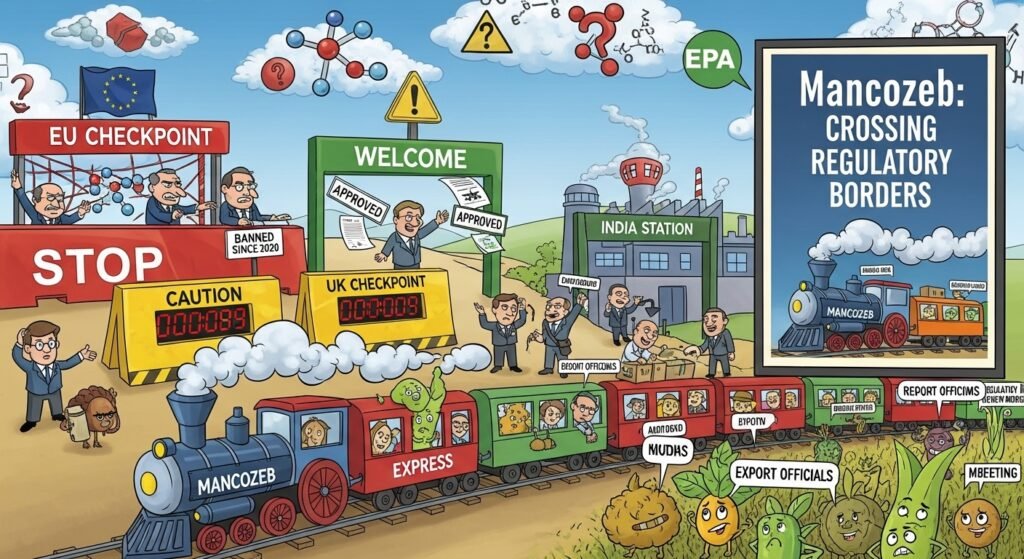
India
India, as the preeminent global purveyor of Mancozeb, finds itself ensnared in a regulatory quagmire of considerable complexity. In 2020, the Ministry of Agriculture and Farmers Welfare embarked upon a comprehensive review of Mancozeb, alongside twenty-six other agrochemicals, contemplating a prospective proscription. Critics, however, have decried the preliminary assessments as lamentably partial, predicated solely upon thyroid profiles from a singular locus, devoid of the rigorous crop residue analyses requisite for an informed decision.
A constellation of Indian stakeholders—including the Indian Council of Agricultural Research (ICAR), the Agricultural and Processed Food Products Export Development Authority (APEDA), farmers’ collectives, and agrochemical enterprises—have championed a measured, evidence-driven approach. They underscore that an abrupt excision of Mancozeb could imperil the export viability of table grapes, potatoes, and other high-value horticultural commodities, with attendant repercussions on both agrarian livelihoods and the nation’s foreign exchange inflows.
Economic and Trade Implications
Globally, Mancozeb undergirds the livelihoods of millions of agrarians and contributes billions of dollars to agricultural export revenues. In India, for instance, table grapes and potatoes—both high-value export commodities—rely extensively upon Mancozeb for efficacious disease management. Downy mildew in grapes and early and late blight in potatoes can wreak havoc on yields if left unchecked, and projections indicate that the excision of Mancozeb could truncate output by 20 to 30 per cent per hectare. Such a diminution would reverberate through India’s export markets, particularly the European Union, the Middle East, and Southeast Asia, potentially eroding the nation’s competitive advantage and diminishing foreign exchange inflows derived from horticultural exports.
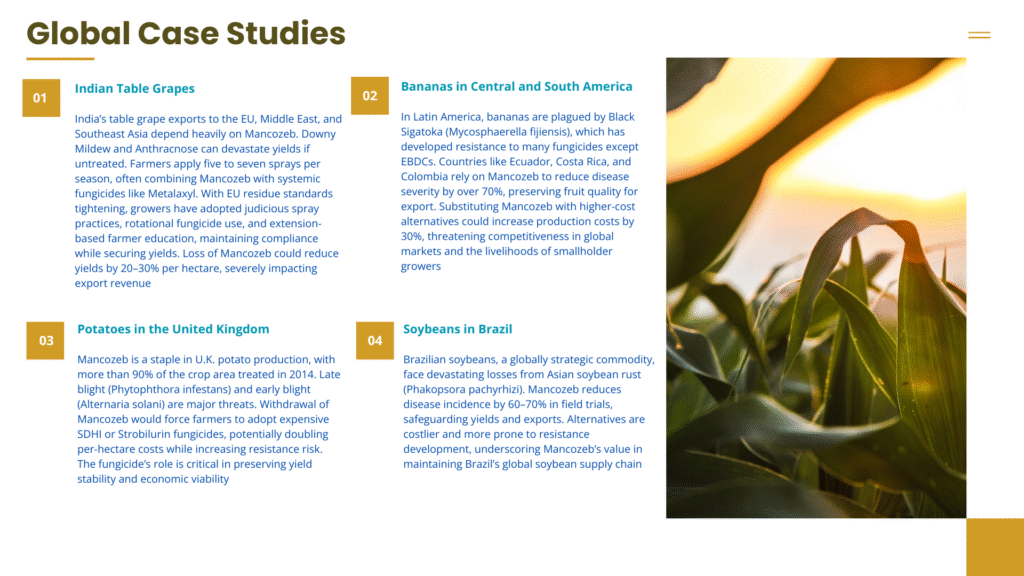
The scenario in Latin America is no less grave, especially in the context of banana cultivation. Black sigatoka, engendered by Mycosphaerella fijiensis, exhibits formidable resistance to many fungicidal interventions, rendering EBDCs such as Mancozeb the most efficacious recourse. Withdrawal of this fungicide would likely escalate production costs by up to 30 per cent, as cultivators would be compelled to substitute either costlier or less effective alternatives, while yields might concomitantly decline due to suboptimal disease control. Such perturbations could undermine the global competitiveness of Latin American bananas, imperiling both large-scale exporters and the smallholder farmers whose very sustenance is entwined with this crop.
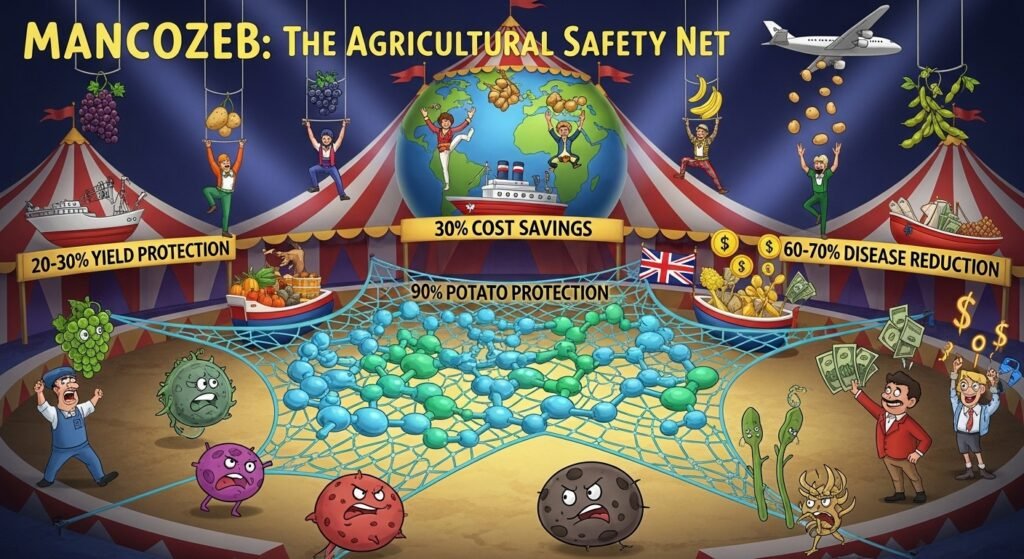
In the United Kingdom, Mancozeb plays an indispensable role in potato cultivation, with over 90 per cent of the crop area routinely treated to mitigate the twin threats of late and early blight. Bereft of Mancozeb, farmers would be compelled to deploy alternative fungicides, such as SDHIs or strobilurins, which are not only more costly but also prone to engendering resistance. This substitution could conceivably double per-hectare fungicide expenditures, compressing margins within an already fiercely competitive agricultural sector.
Brazilian soybean cultivation further exemplifies the global ramifications. Soybeans, a strategic commodity in both domestic and international markets, are vulnerable to diseases such as Asian soybean rust, which can inflict severe yield losses. Mancozeb has demonstrably curtailed disease incidence by 60 to 70 per cent in field trials, preserving both output volume and quality. Its withdrawal would imperil yield stability, destabilise global supply chains, and amplify dependence upon costlier, single-target fungicides, thereby exacerbating resistance pressures over time.
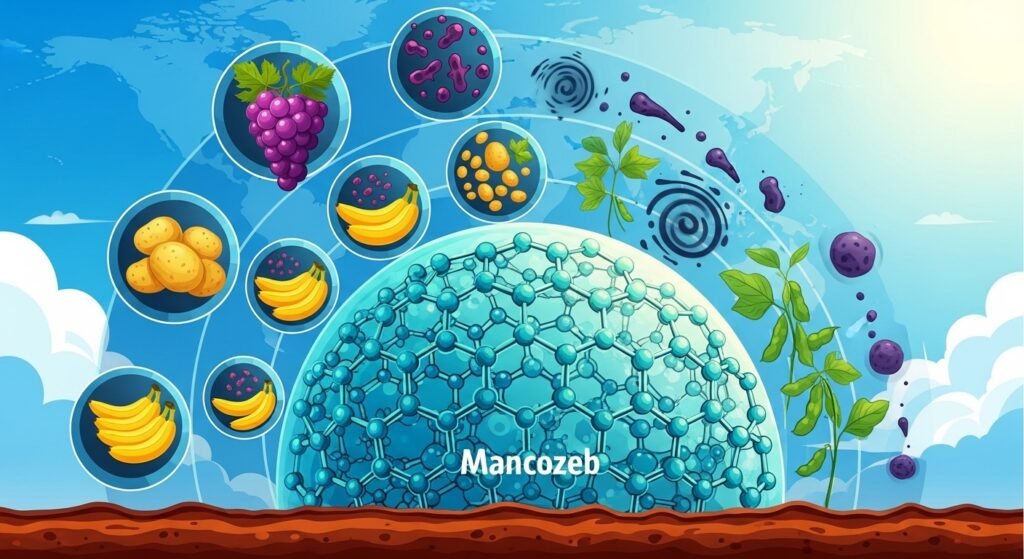
Collectively, these vignettes underscore Mancozeb’s remarkable economic efficacy. It furnishes broad-spectrum disease control at modest cost, with minimal risk of resistance evolution, rendering it indispensable for both high-value and staple crops alike. The prospective consequences of its removal extend beyond mere yield diminution: they encompass escalated input costs, heightened financial vulnerability for farmers, and potential disruption of international trade flows. When juxtaposed with the posited health risks—which, under judicious adherence to Good Agricultural Practices (GAP), remain largely negligible—the economic and food security imperatives of sustaining Mancozeb arguably outweigh the speculative hazards, thereby accentuating the necessity for a nuanced, evidence-based regulatory paradigm.
Conclusion
Mancozeb occupies a singular and paradoxical nexus at the confluence of agriculture, public health, and international commerce—prohibited in Europe, yet indispensable across India, Latin America, and other emerging agrarian economies. Its multisite mode of action, combined with economic prudence and broad-spectrum disease control, renders it an essential instrument for safeguarding high-value crops such as grapes, bananas, potatoes, and soybeans.
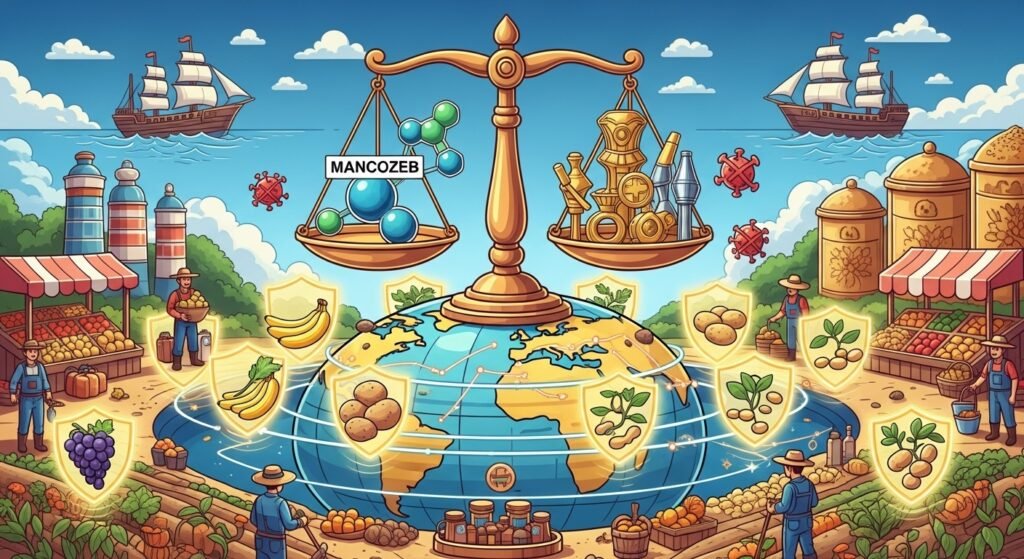
Global case studies consistently illuminate a salient truth: precipitous prohibitions risk imperilling both food security and economic resilience. While toxicological apprehensions warrant meticulous management and sustained scholarly inquiry, an indiscriminate withdrawal devoid of nuanced risk assessment could paradoxically engender greater detriment—manifesting as yield contractions, escalated market prices, and the erosion of farmer livelihoods.
Confronted with the twin imperatives of climate change and the relentless emergence of phytopathogens, alongside the exacting demands of global trade standards, Mancozeb exemplifies the delicate equilibrium between scientific circumspection and pragmatic stewardship. Its narrative transcends the mere pharmacology of a fungicide; it epitomises the broader dialectic of global food security, responsible agrochemical governance, and harmonised regulatory praxis in an intricately interdependent world.
— Suchetana Choudhury (suchetana.choudhuri@agrospectrumindia.com)